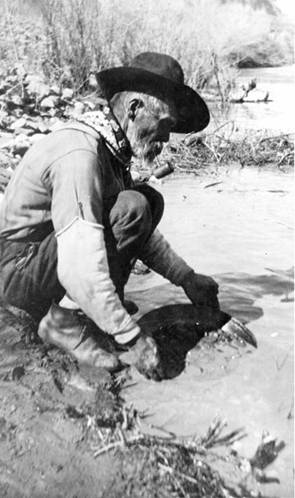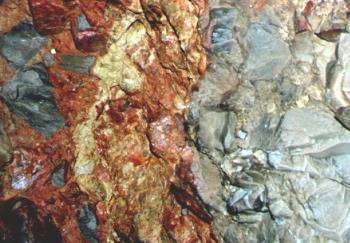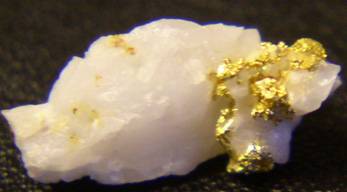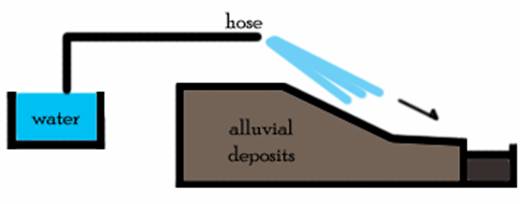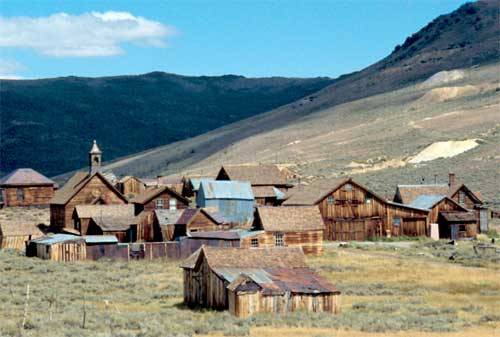Geology and Natural Heritage of the Long Valley Caldera
Keeps Me Searching For a Heart Of Gold:
An Examination of Gold Mining in the West
Erin Monteith
ABSTRACT
The West, in particular California, was greatly changed and developed because of the affects of the California Gold Rush in the mid 1800s. Geology was an integral part of the knowledge needed for success. People who came looking for riches at that time took clues from the rock formations around them to find likely places that gold may have been deposited. Mining techniques varied, but this paper will examine the following: placer mining, dredging, quartz mining, and hydraulic mining. In addition, the processing of gold after it is pulled from the ground will be briefly discussed. All matters will be examined in a historical as well as scientific light, in hopes of coming to understand how gold mining affected California historically, economically, and culturally.From 1848 to 1855, California experienced a great change. Tens of thousands of people flocked there, defying the odds of the climate and the treacherous journey through an expansive desert, creating an economy and living space for themselves in the desert and the mountains beyond. San Francisco began its growth to the city we know today, towns were formed, government put in place, and farming became widespread across the area.
Why did such a revolutionary change happen there? The simplest answer comes in one word: gold.
The California gold rush spurred the development of the West in a big way. People went out to find their fortunes, and though most didn't end up with the great wealth they had dreamed of, they did leave great marks on the West. Because of the efforts of these gold miners and explorers, California was driven to become the beloved and highly populated place it is today. “Approximately 1400 towns or camps existed … during those years.” (Dilsaver, 2) These towns, which were created in hopes of discovering gold, greatly increased the population of California .
The mining towns also created work outside of mining: they needed farming and trade in order to be supported, which boosted California 's economy as well. Unfortunately, many mining towns never made it, and were eventually abandoned. They became the ghost towns of California , which are little more than tourist attractions and places of interest these days. Still, there is no denying that gold mining has left its mark on the West.
Mineral Deposits .
In order to understand gold mining, one must first understand how minerals are deposited. Generally speaking, sediment is deposited when the water, ice, or air that is carrying it can no longer hold it. It will meet some kind of resistance, or feed into a large body that requires more energy for the particles to be carried, which it cannot provide and results in the depositing of the sediment. This can occur in a number of ways.
Sand dunes are created when wind carries sand particles until they hit resistance – usually over a peak or ridge in the sand. In this way, sand dunes are formed as sand particles are repeatedly piled over the same peak.
Similarly, moving water in rivers or streams often drops heavier sediments on the edges of the lakes fed by the rivers. Larger rocks and gravel will be around the edges of the lake, with only the smallest silt and sediment making it as far as the middle of the lake. Ice acts a lot like water in a slower form, and glaciation leaves huge moraines, which are sediment carried along the edges of the ice that is dropped when it becomes too heavy, or when the ice begins to melt.
A final way that sediment can be deposited is through evaporation – when water evaporates, any mineral or sediment that was in it is left behind. When a lake or stream dries up, all the rock and mineral will be left in the stream or lakebed. This is particularly noticeable in places like California 's Mono Lake , where the shoreline is receding and leaving behind large salt deposits because of the high salinity of the water.
Placer Mining
Placer mining, which is the mining of alluvial deposits (sediment deposits created by moving water), is connected to this process. Through placer mining, the deposits of sediment are mined using water, in order to filter pieces of gold or precious metals from piles of rock and sand. This type of mining was very prevalent throughout California during the gold rush, notably the concept of panning for gold. Western movies romanticized the idea of gold rush miners wading into rivers and panning for gold. In reality, panning was done in order to find possible gold deposits, and once gold was found in an area, it was replaced with quicker, more efficient machinery.
Photo 1. Panning for gold in Utah . Photograph an exact reproduction from the Utah State Historical Society.
Mineral Vein Deposits .
Gold is often found in hydrothermal vein deposits. Hydrothermal veins are created when water with dissolved minerals in it moves through a crack or opening in a formation of rock. Usually a combination of heat and pressure keeps the minerals in the water, but as it flows through the rock it will begin to crystallize on the walls of the passage and form a vein of mineral sediment. This sort of formation was very important during the gold rush, as gold veins were some of the primary sources sought out for gold mining.
At the time it was important because a lot of the mining was done by hand, which meant that the gold needed to be readily visible to the miner. Today, the use of mining machinery makes it possible to mine gold and other precious metals that are impossible to see.
Usually, an area with a hydrothermal deposit is quite obvious. The metals in the rock often discolor the rock around it, and the hydrothermal activity in the area can break down the rock into very striking displays. “They force themselves upon the attention even of the unperceptive.” (Young, 375).
Photo 2. Hydrothermal alteration in rock. Figure reproduced from Baker et al. 2005 (exact reproduction)
Locating Gold
Areas that are good for mining are usually very obvious, so it might seem unusual that it took until the 1840s and 50s for people to start mining for gold in California . The difference between gold and most other metals is that gold is a chemically inert metal, and very rare. It has no chemical affect on the minerals around it, making it difficult to locate through traditional geological observation.
Even when one happens upon a vein of gold, that vein is a tiny fraction of the actual mineral content of the rock. Because of this, it doesn't produce the large-scale discolorations like those seen in places like the Artist's Palette in California, where the rock is colored spectacularly due to the hydrothermal activity and staining from the mineral content. Because gold doesn't leave visual clues in this way, it makes it very difficult for miners to tell where gold might be. Gold is generally discovered purely coincidentally. In this way it was discovered in California , in Sutter's Mill in 1848. An employee, James Marshall, discovered flakes of gold, and through that the California gold rush began.
Quartz Mining
Placer mining was the first popular method of mining in California , but it wasn't the only kind of mining. As placer mining began to dissipate, other kinds of mining rose up to take its place, among them quartz mining.
It didn't take long for the miners using the placer methods to follow gold upstream into outcrops of quartz, and they soon began to see the quartz as sources of gold. Initially, they built mine shafts that penetrated the earth up to 300 feet to find the quartz veins, and used methods of rock crushing learned from Latin Americans. Unfortunately, these methods didn't last very long due to a multitude of reasons. Dilsaver describes it as “a combination of inefficiency in the primitive techniques, managerial ineptness, loss of labor to the Nevada mines, and continuous years of flooding.” Clearly, there were a lot of problems with this method.
Photo 3. California Quartz & Gold. Image reproduced from California Gold Miners Website. (Exact reproduction.)
Hydraulic Mining
The third type of mining that this paper will cover is hydraulic mining, which was invented in 1851 and soon became very popular. This mining attempted to find gold “deposited by Tertiary-epoch rivers and left in ridges by subsequent riverine activities.” (Dilsaver, 7)
This was done using water under pressure. The miners would dig channels for the water uphill from where the desired deposits existed, and the water was collected in a pressurized tank. The water would then be sprayed out through a hose, which would basically tear apart the hillside. The debris and sediment that was peeled from the hill by the water would then be searched for gold. This method had many problems. Chief among them was the tendency of the water pressure to damage equipment needed. Miners would attempt to increase the water pressure because it generally wasn't strong enough to completely pull the sediment apart, and when they did this the equipment could no longer withstand the force of the water.
It did, however, have some success, and provided work for hundreds of men in California , doing considerable benefit to the economy. It also provided work for hundreds elsewhere, in factories where the machines were constructed and repaired. Unfortunately, many towns and developments were also forced to move because of the hydraulic mines spreading throughout the region, as well as the environmental impact of the mass amounts of waste debris they left in their wake. Hydraulic mining is still used today, though obviously there have been technological advances since the California gold rush, and there is more regulation on the amount of waste these mines can produce.
Figure 4. Hydraulic Mining Diagram. Image based on figure by J. Engels (2002-2007).
Dredging
Earlier in the paper, placer mining was touched upon briefly. To go more in-depth – other than panning, which was done as a means to locate good gold mining areas, a more complex method is known as dredging.
Dredging is done in lakes or other large bodies of water, and in California it was used and developed a great deal. According to Spence, “ California in particular … would develop a highly sophisticated dredge technology, one that would be disseminated in ever-widening concentric circles for use throughout the globe.” The techniques and technology developed by California miners would eventually spread to other places and change mining everywhere.
To be broadly described, dredging might be likened to a mill on the water. It doesn't seem to be a very pleasant method, unfortunately, being very large, loud, and messy with oil. Still, it was a very prosperous method of gold excavation, and yielded very good results. The first attempts to build working dredges were unsuccessful, and the first successful dredge was actually in Montana in 1895, based upon designs of dredges being made in New Zealand . (Spence 1980).
Despite the late arrival of the dredge to California , the idea had been floating around since the gold rush, in 1850. However, at that time dredges weren't being used for gold mining, but to build canals.
The dredge mining methods soon became extremely popular, largely due to the fact that more investors were willing to fund such operations. Dredge mining was much more reliable than other sorts of mining because bedrock could be drilled to calculate the amount of gold in it before any of the other mining equipment was set up, making it easier to tell where to mine.
The unfortunate side effect of dredge mining was the environmental impact. Dredges polluted the water they floated on, created extremely large amounts of debris, and sometimes would ruin fishing in the area. Some of these problems were similar to those of hydraulic mining (the debris problem in particular) but the dredge mines weren't regulated very closely to prevent the debris accumulation, as it was being attributed to earlier mining endeavors.
There was the added concern of flood damage in dredge towns, which were particularly susceptible due to their location. The dredge mines also destroyed land that, if it had been left untouched, could have been used for farming resources. In a region as arid as California , farming resources must be preserved and utilized, so many people felt that the destruction of the land was too wasteful as a means of harvesting gold. It was possible, in some cases, to re-soil the destroyed land, but unfortunately it wasn't possible in many cases due to the expense. So, while dredging did revolutionize the mining industry, it also caused a lot of problems for the residents of California.
Cyanide and Mercury
Many places used, in addition to other mining methods, a system of cyanide leaching to separate gold from the other material surrounding it. In Bodie , California , while the mine was still in operation, they mined quartz and used both methods of cyanide leaching and mercury to retrieve gold. Cyanidation works through using a solution to extract gold from ore (US Environmental Protection Agency). The ore is mined and placed on pads, it is then crushed and treated with cyanide solution. Usually some sort of a carbon pad will be used, which will attract the gold after it is chemically affected by the cyanide. The waste debris is discarded, leaving only the gold.
Mercury works in a similar way. Miners used liquid mercury, letting it drip through the ore. When the mercury contacted the gold it would turn into an amalgam, a combination of the two metals, and would carry the gold with it. Upon retrieval, the mercury would then be boiled off, leaving only the gold behind.
Obviously, both of these methods are dangerous. Effective or not, cyanide and mercury are both deadly poisons and can cause a great deal of problems for the miners involved in using them to mine gold. Additionally, they become waste products after the gold mining process has finished. There have been problems with mercury pollution moving out into ground and water sources around the gold mines that used them, which creates a unique problem for people in the area because of the dangers it would cause in utilizing water or fish resources from the land there.
Mining's Impact on the West
Mining had a huge affect on the culture of the West. In placed like Bodie, gold was discovered by chance and a town of twenty miners grew to approximately ten thousand. This is an immense increase in population, particularly for such a barren area. Bodie became one of the most famous mining towns in California , and remains one of the most famous ghost towns for tourists out West.
At its peak there were said to be 65 saloons, a Chinatown , and a red light district. The town was immense and extremely active, there are legends that say not a day when by that at least one man wasn't killed. There was a lot of crime, and in many ways it embodies a lot of the mental images that come up from the words ‘Wild West.' As one of the only remaining ghost towns in good condition, Bodie is a valuable resource to study life at the time of the California gold rush. It is also a great example of just how greatly California was affected by gold mining. The population of California grew the way the population of Bodie did… it skyrocketed, and towns sprung up from nothing. It is truly impressive that so much development happened, particularly when one considers the fact that all the buildings were made of wood shipped from elsewhere, as there were no usable trees growing nearby. Gold was a good motivator, it appears.
Photo 5. Bodie Ghost Town. Image reproduced from Robert C. Likes. (Exact reproduction).
Conclusion
Clearly, the West is a very good place to find gold and other precious metals, due to a mixture of the proper mineral environment and the tectonic activities in the area. Hydrothermal activity via steam vents, fissures, and pressurized water can create a place for mineral veins to form, which can be extremely valuable.
The unique landscape of California also makes it a good place to locate and mine for gold and other precious metals. Mining revolutionized the area, increasing the population immeasurably, spurring the agricultural development of the region, bringing a great many immigrants who were interested in mining gold as well. It created jobs for thousands of people and many cities and towns were created during the California gold rush. New mining technologies were created and advanced in the West, and much land that was previously unused became utilized.
Unfortunately, it also brought more than its share of problems, with pollution and environmental concerns. It posed serious environmental and health risks to the people living there. In addition to the physical dangers to the laborers involved in mining, it also posed long-term health risks through the application of poisons in the gold retrieval process. Additionally, land that could have been used for farming before mining destroyed it is no longer usable. Most land that was once fertile for farming, after being mined, can't support plant life without re-soiling – which is too expensive to make it a very viable option.
There is no such thing as clean mining, all kinds of mining produce pollution and physical damage to the environment, making it a bit of a mixed blessing. Though it can provide work for many people, the question is raised of ‘how much is too much?' How much damage to the landscape is acceptable, and how much is too detrimental to continue? It's a question that will likely be asked as long as mining exists, and there is no clear answer.
BIBLIOGRAPHY
Baker, David W. “ Montana Sapphires – the Value of Color”. (2005): www.littlebelt.com/yogo/
Bodie Historic State Park Website. http://www.bodie.com/
Cutter, Donald C. “Some Musings on the Gold Rush and Its Hispanic Heritage.” The Western Historical Quarterly , Vol. 30, No. 4 (1999): pp. 429-433.
Dilsaver, Lary M. “After the Gold Rush.” Geographical Review , Vol. 75, No. 1 (1985): pp. 1-18.
Engles, J. & D. Dixon-Hardy. Hydraulic Mining of Tailings. (2002-2007): http://www.tailings.info/hydraulic.htm
James, L. Allan. “Sustained Storage and Transport of Hydraulic Gold Mining Sediment in the Bear River , California .” Annals of the Association of American Geographers, Vol. 79, No. 4 (1989): pp. 570-592.
Likes, Robert C. “Mono Mills to Bodie.” Explore Historic California . (2006): http://www.explorehistoricalif.com/mono_mills.html
Kerrich, Robert. “Nature's Gold Factory.” Science: New Series , Vol. 284, No. 5423 (1999): pp. 2101
Spence, Clark C. “The Golden Age of Dredging: The Development of an Industry and Its Environmental Impact.” The Western Historical Quarterly , Vol. 11, No. 4 (1980): pp. 401-414.
US Environmental Protection Agency. “Technical Report: Treatment of Cyanide Heap Leachings and Tailings.” (1994)
Young, Otis E. “The Southern Gold Rush, 1828-1836.” The Journal of Southern History , Vol. 48, No. 3 (1982): pp. 373-392.
